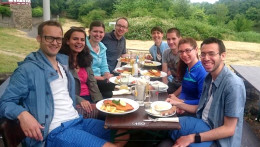Bavarian History Comes Alive: A Tour of the Munich Residence
During a tour of the Munich Residence of the Bavarian rulers, 25 current and former DAAD scholars received fascinating insights into almost 500 years of the country’s history.
Our tour was chronological and began with a model of the Residence, which demonstrates its astonishing dimensions. For a small country like Bavaria, ruled by a dynasty of only regional importance, the Wittelsbachs, the Residence is a very large complex – the largest city palace in Germany.
New buildings and courtyards were continuously added, which was easily possible because there was enough space. Over the centuries, the Munich Residence, the residence and government seat of the Bavarian dukes, electors and kings from 1508 to 1918, became a sizeable complex, with its courtyards and gardens spreading out into the city. The Residence has been a museum for a good hundred years and is now one of the largest castle museums in Europe.
Instead of remodeling the existing buildings, new wings and new rooms, sumptuously furnished according to current tastes, and new works of art were added in each era, from the Renaissance, early Baroque and Rococo to Classicism. The Wittelsbach family thus kept demonstrating their political aspirations and artistic discernment and tastes, primarily based on Italian and French models. We also learned to understand the architecture and the design of the rooms as a material expression of Bavaria’s political development.
One highlight followed the next: The ancestral gallery served to impress friends and foes with the illustrious family tree and family connections to leading dynasties. We were walked and talked through state halls, the East Asian collection, the treasury, the Nibelungen Halls of King Ludwig II. In the Court Chapel, which some of us know from concerts with DAAD alumnus and master violinist Paolo Tagliamento, the late “football god” Franz Beckenbauer was paid homage to at the behest of the Bavarian Prime Minister. An odd location, we thought.
We found the Antiquarium, the oldest almost completely preserved room in the Residence, particularly fascinating. At 66 meters long, this is one of the largest and most magnificent Renaissance halls north of the Alps. Built in the 16th century by Duke Albrecht V for his collection of ancient sculptures, and later adorned with new additions, it served as a banquet hall for his successors. As we were somewhat amused to learn, the food prepared in the kitchen at the other end of the hall was ceremoniously carried along the line of onlooking courtiers to the raised platform where the meal was served. The rulers pursued the principle of “shock-and-awe” not only through architectural and artistic splendor, but also through culinary luxuries, the most valuable tableware and astonishing table decorations.
As grand as life at the court was, we were able to see for ourselves that it had distinct downsides: extremely limited privacy and, in winter, a very uncomfortable indoor climate in the large, high rooms.
The Residence was almost completely destroyed in the Second World War. Works of art and furniture were taken to safe places in good time. Since the war, the buildings have been largely reconstructed true to the original; the Yellow Staircase, which took us up to King Ludwig I’s apartments, was only finished in 2021.
Because the famous Cuvilliés Theater was not accessible due to an event, we postponed our visit until another time. Its architect Francois Cuvilliés the Elder also designed living quarters in the Residence which allowed us to stuy the characteristics of the Rococo. The RG Munich is also planning to once again attend a performance in this important court theater, which, among other things, saw the premiere of Mozart’s Idomeneo.
Much as we saw and learned in well over three hours, we have by no means exhausted the treasures of the Residence with its over 150 showrooms and will definitely be back.
Mark Hovsepyan und Sibylle Wahl, DAAD-Freundeskreis Regional Group Munich
Additional information
Categories
- General (17)
- Germany Behind the Scenes (8)
- Reports (52)
Keywords
- Berlin (22)
- Bonn (7)
- Bonn Dr. Christian Bode (1)
- Braunschweig-Hannover (1)
- Cologne (1)
- Dresden (4)
- Düsseldorf (2)
- Freiburg (2)
- Hamburg (2)
- Heidelberg (1)
- Karlsruhe (1)
- Marburg (1)
- Munich (8)
- Rhine-Main (3)
- Rhine-Neckar (2)
- Saarland (1)
- Stuttgart (1)
- Trier (1)
- Tübingen (3)

